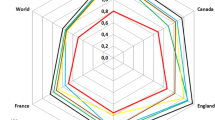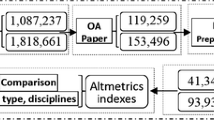Abstract
Along with China’s economic emergence is a controversy over the quality and international visibility of citation index publications. This study uses bibliometric statistics to shed further light on the global landscape of citation index publications with special focus on China and the USA. The analysis explores 31 years of the TRS (Thomson Reuters Scientific) database, spanning the 1980–2010 period. Based on this study, the USA maintains global dominance for both WOK (Web of Knowledge) and WOS (Web of Science) TRS publications. Although China ranks a distant second for WOK, it lags behind five other nations for WOS publications. China’s scientific base needs further restructuring for greater global visibility. Emerging economies such as China, India, Brazil and South Africa are fast rising in the global ranks for WOK/WOS publications. China may already be leading the world in some publication attributes, although it could take several more decades to catch up with the USA in others. Normalizations of the publications with population, PTE (population with tertiary education) and GDP (gross domestic product) put small/low-population countries in the global lead. However, countries such as Canada, Greenland, Iceland and Sweden still rank high for most of these publication attributes. Furthermore, WOS per WOK analysis shows that small and/or economically weak countries place greater emphasis on WOS publications. This is particularly visible for countries in Africa and South America. Despite the addition of a large number of indigenous Chinese journals to the TRS database, prediction analysis suggests that China’s desire to surpass the USA could be delayed for several decades. In the race for the next-generation scientific superpower, however, China not only needs to sustain substantial investments in research and development, but also requires restructuring of its research industry. This is especially critical for data readiness, availability and accessibility to the scientific community, and radical implementations of research recommendations.











Similar content being viewed by others
References
Aksnes, D. W. (2003). Characteristics of highly cited papers. Research Evaluation, 12(3), 159–170.
Cole, S., & Phelan, T. (1999). The scientific productivity of nations. Minerva, 37(1), 1–23.
Conway, S. G., Waage, J., & Delaney, S. (2010). Science and Innovation for Development. UKCDS. http://www.ukcds.org.uk/publication-Science_and_Innovation_for_Development-172.html
De Bellis, N. (2009). Bibliometrics and citation analysis: from the Science citation index to cybermetrics. Scarecrow Press, 417. ISBN 0810867133.
Fung, I. C. H. (2008). Citation of non-English peer review publications—some Chinese examples. Emerging Themes in Epidemiology, 5(12). doi:10.1186/1742-7622-5-12.
Gorraiz, J., Reimann, R., & Gumpenberger, C. (2011). Key factors and considerations in the assessment of international collaboration: a case study for Austria and six countries. Scientometrics. doi:10.1007/s11192-012-0638-4.
GR&DFF. (2011). 2011 Global R&D Funding Forecast; Globalization Narrows R&D Gap Between Countries. http://www.battelle.org.
Guan, J., & Gao, X. (2008). Comparison and evaluation of Chinese research performance in the field of bioinformatics. Scientometrics, 75(2), 357–379. doi:10.1007/s11192-007-1871-0.
Hao, X. & Gong, Y. (2006). China Bets Big on Big Science. Science, 311, 1548–1549. http://www.sciencemag.org.
He, T., & Liu, W. (2009). The internationalization of Chinese scientific journals: Aquantitative comparison of three chemical journals from China, England and Japan. Scientometrics, 80(3), 585–595. doi:10.1007/s11192-008-2067-y.
Hirsch, J. E. (2005). An index to quantify an individual’s scientific research output. Proceedings of the National academy of Sciences of the United States of America 102, 16569–16572.
Jiang, J. (2011). Chinese science ministry increases funding. Nature,. doi:10.1038/news.2011.515.
Kuemmerle, W. (1999). The drivers of foreign direct investment into research and development: An empirical investigation. Journal of International Business Studies, 30(1), 1–24.
Larivière, V., & Gingras, Y. (2010). On the relationship between interdisciplinarity and scientific impact. Journal of the American Society for Information Science and Technology, 61(1), 126–131.
Larivière, V., Gingras, Y., & Archambault, É. (2009). The decline in the concentration of citations. Journal of the American Society for Information Science and Technology, 60(4), 858–862.
Larivière, V., Macaluso, B., Archambault, E., & Gingras, Y. (2011). Which scientific elites? On the concentration of research funds, publications and citations. Research Evaluation, 19(1), 45–53.
Leimu, R., & Koricheva, J. (2005). Does scientific collaboration increase the impact of ecological articles? BioScience, 55(5), 438–443.
Leydesdorff, L. (2012). World shares of publications of the USA, EU-27, and China compared and predicted using the new Web of Science interface versus Scopus. El profesional de la información, 21(1), 43–49.
Li, J., & Yue, D. R. (2005). Managing global research and development in China: Patterns of R&D configuration and evolution. Technology Analysis & Strategic Management, 17(3), 317–337.
Li, L., & Zhang, F. (2003). Developing English-language academic journals of China. Scientometrics, 57(1), 119–125.
Lin, M., & Zhang, J. (2007). Language trends in nanoscience and technology: The case of Chinese-language publications. Scientometrics, 70(3), 555–564. doi:10.1007/s11192-007-0302-6.
Martínez-Bueno, M., Gálvez, A., Maqueda, M., & Valdivia, E. (2000). Scientific publication trends and the developing world. American Scientist, 88(6), 526–533.
McVeigh, M. E. (2005). Journal self-citation in the Journal Citation Reports®—Science Edition (2002): A Citation Study from The Thomson Corporation. http://www.thomsonscientific.com/media/presentrep/essayspdf/selfcitationsinjcr.pdf. Accessed 12 May 2007.
Moed, H. F. (2002). Measuring China’s research performance using the Science Citation Index. Scientometrics, 53(3), 281–296.
Persson, O. (2010). Are highly cited papers more international? Scientometrics, 83, 397–401.
RSR (2011). The Royal Society Report 2011: Knowledge, networks and nations Global scientific collaboration in the 21st century. http://royalsociety.org/uploadedFiles/Royal_Society_Content/Influencing_Policy/Reports/2011-03-28-Knowledge-networks-nations.pdf. Accessed 5 Jan 2012.
Suttmeier, R. P., Cao, C., & Denis Fred Simon, D. F. (2006). Priorities and funding: “knowledge innovation” and the Chinese Academy of Sciences. Science, 312(58), 58–59. doi:10.1126/science.1122280.
TRAR. (2010). Thomson Reuters 2010 Annual Report. http://ar.thomsonreuters.com/files/Annual_Report_2010.pdf. Accessed 5 Jan 2012.
Van Leeuwen, T. N., & Tijssen, R. J. W. (2007). Strength and weakness of national science systems. A bibliometric analysis through cooperation patterns. Scientometrics, 79(2), 389–408. doi:10.1007/s11192-009-0426-y.
Wang, S., Wang, H., & Weldon, P. R. (2007). Bibliometric analysis of English-language academic journals of China and their internationalization. Scientometrics, 73(3), 331–343.
Wormell, I. (1998). Informetric analysis of the international impact of scientific journals: How ‘international’ are the international journals? Journal of Documentation, 54(5), 584–605.
Zelnio, R. (2011). Identifying the global core-periphery structure of science. Scientometrics. doi:10.1007/s11192-011-0598-0.
Zhou, P., & Leydesdorff, L. (2006). The emergence of China as a leading nation in Science. Research Policy, 35, 83–104.
Zhou, P., & Leydesdorff, L. (2007). The citation impacts and citation environments of Chinese journals in mathematics. Scientometrics, 72(2), 185–200. doi:10.1007/s11192-007-1713-0.
Acknowledgments
This study is supported by the China-Africa Science and Technology Partnership Program (CASTEP). We are thankful for the incredible inputs of the anonymous reviewers and editors by way of insightful comments and suggestions.
Author information
Authors and Affiliations
Corresponding author
Electronic supplementary material
Below is the link to the electronic supplementary material.
Rights and permissions
About this article
Cite this article
Moiwo, J.P., Tao, F. The changing dynamics in citation index publication position China in a race with the USA for global leadership. Scientometrics 95, 1031–1050 (2013). https://doi.org/10.1007/s11192-012-0846-y
Received:
Published:
Issue Date:
DOI: https://doi.org/10.1007/s11192-012-0846-y




